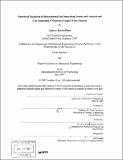Numerical simulation of hydrothermal salt separation process and analysis and cost estimating of shipboard liquid waste disposal
Author(s)
Hunt, Andrew Robert
DownloadFull printable version (10.27Mb)
Other Contributors
Massachusetts Institute of Technology. Dept. of Mechanical Engineering.
Advisor
Jefferson W. Tester.
Terms of use
Metadata
Show full item recordAbstract
Due to environmental regulations, waste water disposal for US Navy ships has become a requirement which impacts both operations and the US Navy's budget. In 2006, the cost for waste water disposal Navy-wide was 54 million dollars. There are many advanced waste water treatment technologies in the research and development stage at academic institutions, private corporations, and government labs. Additionally, considerable progress has been made in installing and operating unique waste water treatment systems onboard merchant and commercial vessels, showing that waste water treatment technologies are near the maturity level required for installation on US Navy ships. Installation and operations costs can be estimated from data collected from merchant ships, but the accompanying life cycle liquid disposal costs savings can be difficult to estimate. A cost estimator is presented which allows variations in ship's operational schedule and aids in determining the total life cycle savings, and the time for return on investment, when waste destruction technologies are installed in a class of ship. Additionally, the properties of one waste water destruction medium, supercritical water, are reviewed and its use in efficient and environmentally safe chemical processes are discussed. (cont.) In particular, supercritical water is the medium of choice for the performance of a biomass to synthetic natural gas conversion process. The supercritical water is utilized to aid in a vital salt separation process which allows for efficient hydrothermal gasification. Numerical simulations of the salt separation process are completed which help in understanding the flow properties. The results will aid in yielding an optimized salt separation process, improving the efficiency and viability of the conversion process.
Description
Thesis (Nav. E. and S.M.)--Massachusetts Institute of Technology, Dept. of Mechanical Engineering, 2007. Includes bibliographical references (p. 87-89).
Date issued
2007Department
Massachusetts Institute of Technology. Department of Mechanical EngineeringPublisher
Massachusetts Institute of Technology
Keywords
Mechanical Engineering.